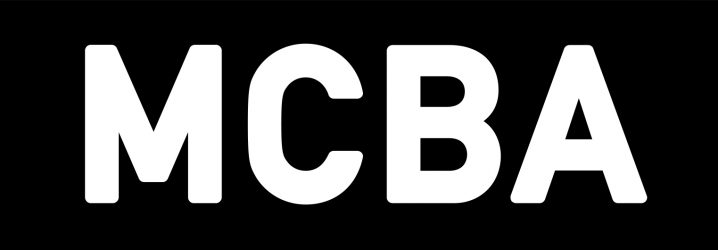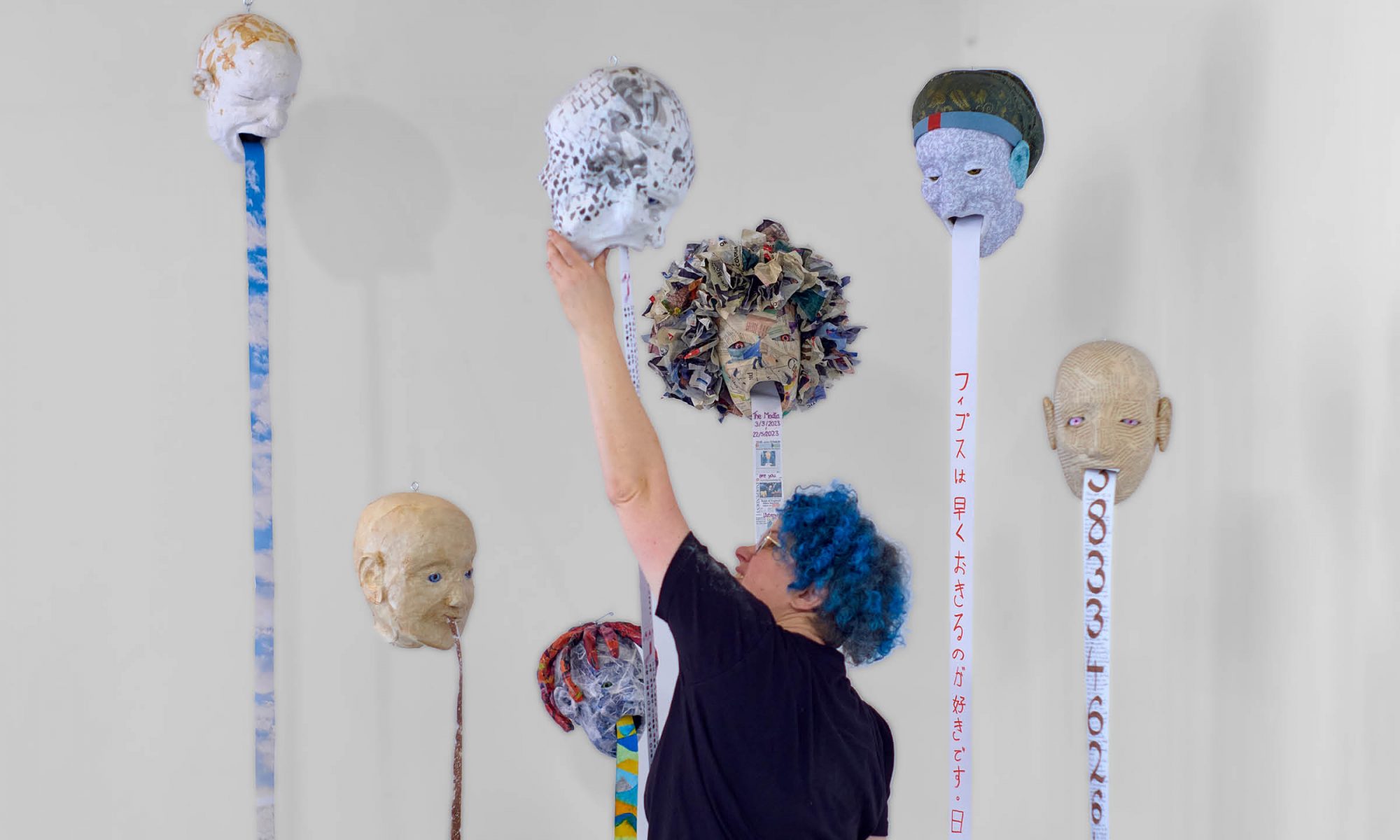MCBA Outlook Gallery
October 7, 2023–January 27, 2024
Free and open to the public
VIEWABLE FROM THE STREET (AND FROM INSIDE THE SHOP DURING OPEN HOURS)
Others is a book art installation consisting of seven paper mâché heads. Each of the heads are a case for the scroll that spills out of the head’s mouth.
An immigrant to my country, I am broadly interested in language, cultural norms and how they relate to each other, and in what makes us see someone as other or the same. In recent years the growing tendency to make and declare whole groups as so alien and other to us that they do not deserve dialogue has split societies everywhere. This installation is made to challenge the viewer to bear with difference and investigate for themselves what makes someone other to them.
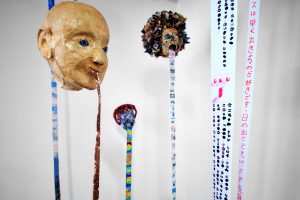
I sculpted each of the heads with several different references to keep each one ambivalent racially, and in respect to age and gender. They ask the viewer to reflect: Which of them seem other, which seem same? Why is that? And does that change your interaction with the content this sculpture presents?
One of the references for the head “The Mystic” was, for example, from a people who elongate their heads by applying pressure to the heads of their young children. They hope that a longer head makes the children more intelligent, but also to satisfy aesthetic ideals. Cranial formation practices were and are common amongst a variety of peoples across Earth and history. A Unilad article on the practice of head binding ends with the sentence “The practice is much less common nowadays, but it’s not necessarily obsolete and is thought to still occur in some remote communities.” I beg to differ that it is only “remote communities”—The practice of giving little children “helmets” to correct their head shape is quite common in the US nowadays, driven by the same wishes of parents for their children. The fact that there is a fundamental difference perceived in helmet therapy and the headbinding technique of other cultures is part of what I want to address with this work.
The seven books are individually titled: Whipped up, Pi, The Media, Nature and Men, Colours and Shapes, The Mystic, The Storyteller.
Whipped up: When someone is making themselves look and sound greater than they are, we call them “Schaumschläger” in German, which literally translates to “foam-beater/producer.” Also, when in English one would say someone is talking bullshit, in German we would say they talk mixed up shit. On the scroll, apart from a rendering of brown foam and bubbles, you’ll find single short words or nonsensical individual letters.
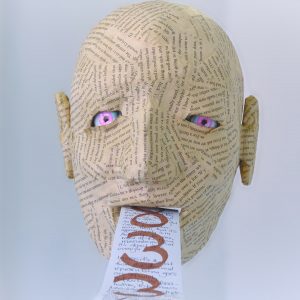 Pi: This head’s skin is made up from pages of a book on finance. On the scroll (written from bottom to top) you’ll find a decimal approximation of Pi and, written from top to bottom, “Thoughts on Pi by a mathematician,” an essay by H. Kurzke. In the essay I wonder why Pi holds such fascination to many people and what sets it apart from other numbers that do not share this popularity.
Pi: This head’s skin is made up from pages of a book on finance. On the scroll (written from bottom to top) you’ll find a decimal approximation of Pi and, written from top to bottom, “Thoughts on Pi by a mathematician,” an essay by H. Kurzke. In the essay I wonder why Pi holds such fascination to many people and what sets it apart from other numbers that do not share this popularity.
The Media: The head is finished in newspaper and the scroll is printed on fabric and shows newspaper frontpages and news stories between March 3 and May 23, 2023. I selected only “serious” papers but across the political spectrum. Some will title in a way that aligns with a viewer’s position and others won’t. The embroidered text asks them: “Do you listen?”
Nature and Men: The head is finished in a handmade paper with natural leaf prints on it. The expression is somewhere between awe and pain. The scroll coming out from its mouth shows the sky during sunrise behind a mast for a high voltage power line.
Colours and Shapes: The head has an unnatural blue tint, and has an colourful scroll with abstract shapes that at places come together to resemble skylines and landscapes. I imagine someone unpolitical, careless, enjoying life.
The Mystic: One of the references for this head was from a people who elongate their heads by binding young children, as mentioned above. The head is finished in Asian calligraphy paper, some of which is covered in brush marks in sumi ink, giving another unfamiliar aspect to the sculpture. The scroll is made by cutting into the stamps at the back of pencils. I then stamped out the text of the Rubaiyat of Omar Khayyam (in translation to English), using each symbol to represent one letter of the alphabet. While stamping the text, the fragile stamps break and deteriorate, making the individual letters harder and harder to distinguish. In the end, they are all very similar to each other.
The Storyteller: This scroll features the beginning of a story I wrote myself about the tricks a young boy named Fips is, sometimes without intention, playing on his grandmother. It is written in Japanese, and it’s the writing system that really makes the scroll stand out here, standing for a different culture and different script. Google lens will read the text for you, though. And at the bottom is a QR code that can take you to read the full story (in Japanese).
—Hilke Kurzke
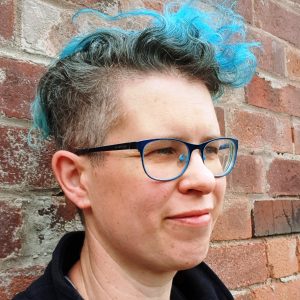 Hilke Kurzke is a book artist, writer, printmaker, and organizer of the bi-annual Notts Book Arts Festival. Born and educated in Germany, she now lives and works in Nottingham, England.
Hilke Kurzke is a book artist, writer, printmaker, and organizer of the bi-annual Notts Book Arts Festival. Born and educated in Germany, she now lives and works in Nottingham, England.
Kurzke prefers to explore the fringes of what makes a book while examining our use of language, how we speak and react to others. The topic of hidden meaning and content permeates her work, from literally hiding book art pieces in her community—hiding parts of a story behind flaps and in hidden compartments and works in secret script—to making her books inaccessible by putting them into containers that have to be destroyed to reach the hidden content.
Many of her works draw from the personal experience of being an immigrant, a mother, and a woman, recreating the experience of being talked to rather than with, and the cultural norms and expectations that are concealed within language.
In her recent body of work she has used paper mâché to create sculptural containers for her books and prints.

